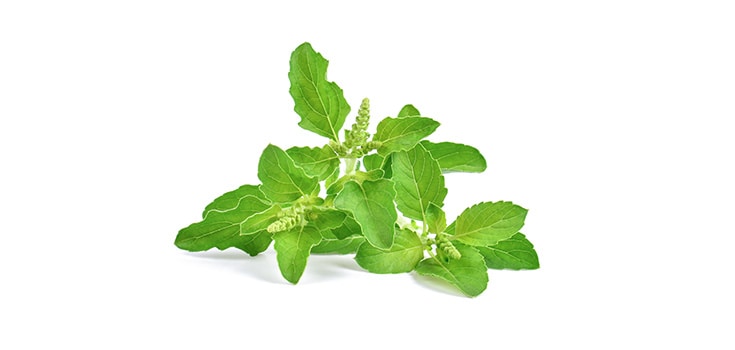Holy Basil Benefits: Growing Your Own Medicine

All herbs have a purpose—whether it’s culinary or medicinal—but, it’s a particularly good sign when an herb is revered as the “queen of herbs” and is held as a holy plant worthy of worship. This plant, holy basil (tulsi), not only has medicinal benefits, but is also said to have spiritual benefits. What’s more, holy basil benefits can be experienced in an exciting way, as the herb can be grown in your home or on your patio – making it a great addition to your healing herb garden.
Holy basil, or tulsi (Ocimum tenuiflorum) is a member of the mint family. It’s closely related to the sweet basil you add to Italian dishes and pesto, but the flavors are quite different. This plant is sometimes referred to as pepper basil as it’s clove-flavor is spicier than it’s sweet counterpart.
The shrub can grow to about 30 to 60 cm high, has hairy stems and green (sometimes purple-tinged) small leaves. When allowed to flower, the blossoms are violet. It’s native to Eastern tropical regions and is especially widely known in India and Hindu countries where it is revered as a holy plant.
History and Spiritual Significance
In Hinduism, holy basil is worshiped as the incarnation of Lakshimi, the wife of Vishnu and one of that religion’s most important deities. It is called “The Incomparable One” and “Mother Medicine of Nature” among other things, and can be seen growing outside of Hindu temples.
Not only found in temples, you will see tulsi being cultivated outside of most Indian homes and in courtyards. In worship, it will be placed on an altar and held in reverence during meditation and prayer.
Though the herb has likely been growing in India the longest (an estimated 3,000 years), it was also prized by healers of ancient Greece and Rome and continues to be prized throughout the world as a plant that can heal the body, mind, and spirit. But all potential spiritual benefits aside, the herb undoubtedly brings numerous health benefits to the table.
Some Holy Basil Benefits
In Ayurvedic medicine, holy basil has been used for thousands of years. However, it is just in recent decades (and especially the past few years) begun gaining popularity in the West.
The plant is said to be an adaptogen. Adaptogens essentially adapt to serve the body where it needs them most. Typically, adaptogens are characterized as stress-busters, and this is where we will find the majority of research on tulsi.
While all scientific research on the plant has been done on lab animals and not reproduced in humans, case after case of anecdotal evidence and thousands of years of use can’t be wrong.
Holy basil has numerous beneficial properties including:
- Adaptogenic (anti-stress)
- Antibacterial
- Anti-fungal
- Antioxidant
- Anti-inflammatory
These properties alone can account for many potential benefits including increased sense of well-being, increased immune function, and disease prevention.
Known benefits of holy basil include:
- Memory booster
- Fever reduction
- Cough soothing
- Sore throat relief
- Soothing to bites, cuts, and scrapes
- Headache treatment
- Increased kidney function
- Balanced emotional health
- Clearing acne
- Possible blood sugar regulation
Both as a general health tonic and as a treatment for specific maladies, tulsi has been the go-to herb for millennia. Experience holy basil benefits today – by growing your own!
How to Grow Holy Basil
Tulsi is an excellent addition to any herb garden and can do well in either pots or in the ground. It prefers warm soil, so don’t plant seeds until after the last frost of the season and when the average daily temperature is 65 to 70 Fahrenheit. Alternately, you can start with a small plant and transplant it to the garden or pot to have a head start.
The holy basil plant prefers sunlight, so don’t place it in a shady spot. A little afternoon shade would be okay, but full sun is best. Be cautious that it gets plenty of water, as drying out in the hot summer sun could mean certain death.
As it grows it will develop flowers. To encourage a larger, bushier plant, you can pinch off these blossoms. However, most sources say that letting the plant flower won’t affect its healing potency much.
A note on harvesting: The flowers of your tulsi plant will bring plenty of bees to the garden, so if you want to harvest without risking a sting, head out to your garden first thing in the morning.
Clip those parts higher than 5 inches and without flowers for the best leaves. Careful not to harvest more than you need as over-harvesting can harm a not-quite-established plant.
Using Holy Basil
Most practitioners will use holy basil in a tea, and this is the easiest way to reap holy basil benefits. Simply cover 2 teaspoons of fresh tulsi leaves with 8 ounces of boiling water, then cover and let steep for about 5 minutes before straining the leaves off and drinking.
Alternately, there are many commercial holy basil products. While growing your own is the very best (and not that difficult), it’s not for everyone. If you don’t have a green thumb and are tempted to opt for those already-prepared versions, make sure you are looking for high quality and organic products.
Additional Sources:

I drink several cups of organic Krishna Tulsi Tea everyday. It makes me feel calm and balanced and I have a feeling it has untold benefits on my well-being as a whole.
Thank you for posting this article – I will cultivate my own come Springtime !
I love basil, it is exactly the kind of plant that you often use in your daily diet. Therefore, if you still don’t know where to start when planting your garden, choose those plants that will be useful to you in everyday life.